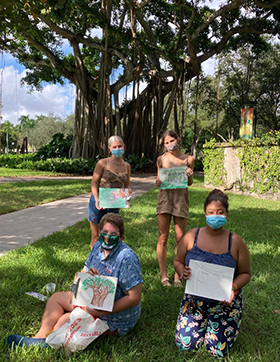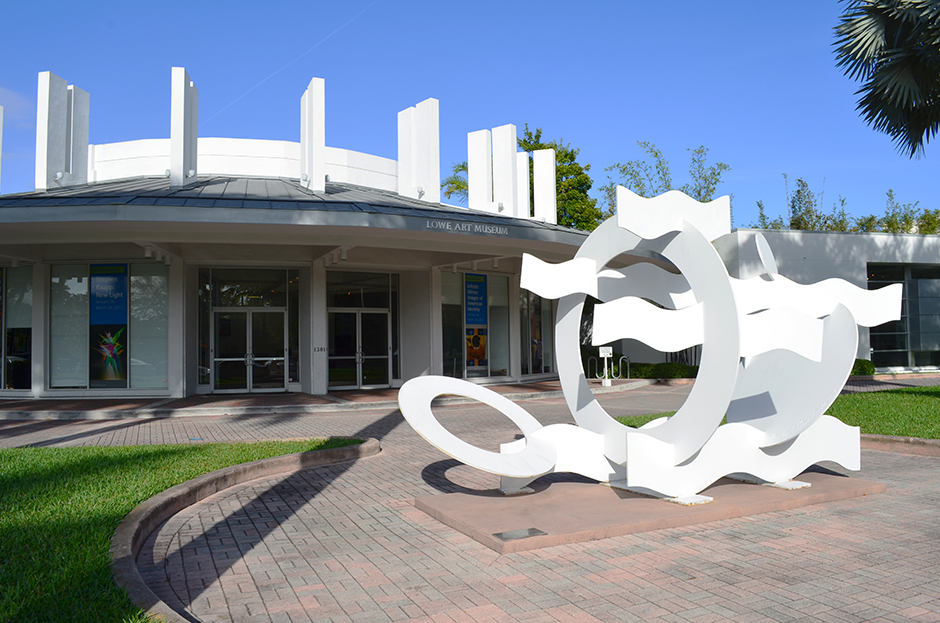The University of Miami’s Lowe Art Museum marked its 70th anniversary in February of 2020, just a few weeks before the COVID-19 pandemic shut everything down. The museum remains closed to the public and available to UM students and faculty on only a limited basis, including an art class called “USketch” meeting weekly through the fall semester.|
Even so, the Lowe has continued to offer an array of interesting, fun, and even whimsical activities and events for students. Most are in the online virtual sector; others take place beyond the museum’s walls.
“The idea has been, while trying to minimize the spread of the virus, to focus on things that can be done outside around campus,” said Bridget O’Brien, the Lowe’s communications specialist.
 “We did a lot of outreach to colleagues around the country and even internationally, brainstorming ideas for programming,” adds Mark Osterman, the Lowe’s digital experience manager and head of education. “In addition to leaning into existing digital practices, we’re looking for innovative ways to create new experiences to engage the community.”
“We did a lot of outreach to colleagues around the country and even internationally, brainstorming ideas for programming,” adds Mark Osterman, the Lowe’s digital experience manager and head of education. “In addition to leaning into existing digital practices, we’re looking for innovative ways to create new experiences to engage the community.”
To that end, the Lowe has offered a variety of online sessions overseen by the museum’s education team.
“Lowe on the Go” was the museum’s first response to staying engaged with the public during the pandemic. Originally distributed daily but now released each Wednesday, the initiative delivers a single work of art from the Lowe’s collections via email and social media.
“Lowe Connects,” a wide-ranging online series of discussions and lectures with faculty and students, has explored the work of African-American historical painter Jacob Lawrence and featured the student-curated bilingual virtual exhibition “11 Intervisual Cubans.” The digital events have drawn up to 100 attendees.
Because the webinar format is less engaging, “We use the Zoom platform so attendees can see each other,” said Christina Larson, Andrew W. Mellon Fellow for Academic Engagement at the Lowe. “Rather than one-way lectures, we try to make the sessions more conversational. The series has allowed us to develop positive and intellectually engaging programming to help foster connection during the pandemic.”
Insights, Inspirations, and the Great Outdoors
As part of her duties with the Lowe and UM Libraries, Larson is also involved with the Andrew W. Mellon Foundation’s CREATE Grants program. CREATE has awarded more than $135,000 to 23 projects at the University of Miami.
Among them is the mobile-device app GeoMuseUM, initiated by School of Communications faculty member Lien Tran, an expert in interactive and social media, and Dr. Diana Ter-Ghazaryan, formerly of UM’s Department of Geography and Regional Studies and now GIS Research Associate at Florida International University.
The Lowe is putting GeoMuseUM to use on a number of fronts—among them, serving as a guide to the more than 30 Lowe sculptures that dot the Coral Gables campus.
“We created the app to get people thinking about art, health, and well-being,” said Osterman. “It’s especially beneficial to be in outdoor spaces during COVID, exploring our beautiful campus environment. It also helps students, especially freshmen, navigate the campus while learning about the Lowe’s collections on their personal mobile devices.”
In addition to its applications for teaching and coursework such as sketch classes, GeoMuseUM is facilitating a melding of visual art and music through a collaboration between the Lowe and Frost School of Music faculty members Melvin Butler and Brent Swanson.
Butler’s and Swanson’s music composition students are assigned to choose a particular sculpture from the Lowe’s collection, then create a composition inspired by it. The compositions are curated by faculty and uploaded to the app. “So,” said Osterman, “you can learn about a piece while having an immersive sound experience that complements it—a cool and exciting adaptation.”
Miami English composition Professor Nick Pici is utilizing the museum’s encyclopedic permanent collection of more than 19,000 pieces for his classes on visual literacy.
Pici assigned students to write papers interpreting a set of artworks. To ensure students who wanted to visit the museum in person could do so, Larson and her team made arrangements for 15 students to see the space and its physical objects in a safe way.
“It was tricky to manage,” she said, “but, overall, everyone was very pleased.”

